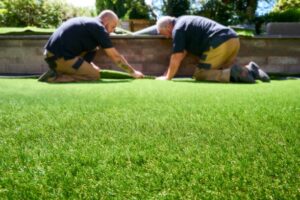An artificial grass installation Adelaide project can be a labour-intensive and technically challenging project for homeowners. One missed step could result in a lawn that doesn’t look good or perform well.
The first step is to prepare the area. This includes clearing away rocks, high spots and debris. It’s important to get the ground level, as uneven landscape can cause problems later on.
How to Choose the Right Grass
 There are many different types of synthetic turf on the market, so it can be difficult to navigate. However, by learning some do’s and don’ts when shopping for artificial grass you can ensure your project is a success.
There are many different types of synthetic turf on the market, so it can be difficult to navigate. However, by learning some do’s and don’ts when shopping for artificial grass you can ensure your project is a success.
The first step in the process is choosing a turf type that fits your project and budget. There are a number of things to consider including the face weight, pile height, infill, backing, thatch colour, and blade shape. These details can be found on a turf distributor’s website or by speaking with a representative.
For example, if you have children or pets and the area will be heavily trafficked you will want to opt for a pet-friendly lawn that is designed to handle urine and excrement. This will require a higher quality turf with shaped blades and a longer pile height than a residential landscape yard.
Additionally, it is important to consider the average weather in your area. Look for turf that has good drainage and can withstand heavy rains to prevent unsightly water pools and mold growth. It is also important to look for a synthetic lawn that has cooling technology to dissipate heat, especially in hot climates. When it comes to budget, you should be able to find the right turf at a price that is within your price range.
Preparation
Know that artificial grass installation Adelaide can be a challenging do-it-yourself project. Homeowners often hire landscape professionals to get the job done right. This is usually the best way to ensure a well-laid surface that won’t sag, buckle or lift up and to create a safe, stable lawn that minimizes trip hazards. However, experienced DIYers can also handle this project with the help of a landscaping company.
The first step is preparing the base for your artificial turf. A solid, compacted base is essential for drainage and to prevent weeds from growing up through the turf. To create a good base, spread builders sand over the area and use a landscape rake to distribute it evenly. Then, use a tamper or 2X2 piece of plywood and a rubber hammer to flatten the sand until it’s firm and level.
Once the base layer is ready, give it a quick watering to make sure that there aren’t any dry spots. Then, sweep it clean with a push broom and prepare for final compaction with a plate or drum compactor. When you’re finished, the area should be as smooth and level as concrete. You may need to make several passes with the compactor to reach acceptable levels of compaction. Avoid over-compacting – this could weaken the foundation and cause drainage problems. Lastly, make sure that the edging detail is secured and that all rocks or high spots are removed to ensure an even surface.
Installation
For many homeowners, the thought of tackling an entire landscaping remodel can be intimidating. However, artificial grass installation Adelaide can be a simple and efficient way to get the yard you’ve always wanted without spending too much time or money. Before you start the project, check to make sure there are no existing pipes, gas, water or electric lines in the area you’ll be working on. If you are unsure, call your local utility company before beginning the excavation process. They’ll send someone out to mark your property lines for you.
Once the area has been prepped, a layer of base is needed to improve drainage and prevent slumping. In most climates, a 3-4 inch layer of type 1 stone or gravel will do the trick. You may also choose to use a class II road base, decomposed granite, or crushed rock. A weed barrier layer is also an option, but not necessary for most areas.
After the base is laid, it’s important to rake out any loose dirt or rocks to ensure the surface is smooth and ready for turf. Then, stretch the turf out and nail it down along the edges with 7-inch lawn spikes. Be careful to only nail down about a foot around each edge, so you don’t create dips in the turf when people or pets walk on it.
